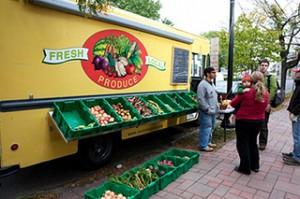
I guess you could call me a foodie. I find Anthony Bourdain’s travels around the world to be fantastic TV. I think Michael Pollan’s advice to “eat food, not too much, mostly plants” to be great words to eat by. My two favorite meals range from one of DC’s swankiest locales to the kitchen at my Thai friend’s house eating crabs. My knowledge regarding food seems to have paralleled popular culture’s growing obsession with food, from shows to talking heads to gastronomic experimentation. But my interest in finding that next great meal is waning. I’m lucky to have immediate access to fresh food. Not everyone else is so blessed.
There is a growing body of research into the causes and effects of food deserts, i.e. parts of the country lacking fresh fruit, vegetables, and other healthful whole foods, usually found in impoverished areas. Part of the First Lady’s Let’s Move initiative to end childhood obesity includes the United States Department of Agriculture’s (USDA) Food Access Research Atlas which provides essential data on where there is limited healthy food access.
As part of University of Michigan’s Detroit School: Conversations in Urban Studies, Professor Andrew Deener from the University of Connecticut presented on his forthcoming book, “Feeding Philadelphia: Risk, Efficiency, and the Transformation of the Food System”. His work provides the historical context for how the development of the food distribution system has resulted in numerous food deserts throughout many urban areas. In response to the deindustrialization, suburbanization, and real estate “redlining” that depopulated America’s urban areas, the food distribution system’s infrastructure resulted in the exclusion of numerous populations. The consolidation of numerous neighborhood grocery stores into central supermarkets was partly due to two factors: the low profit margins for fresh produce and the fact that the old wholesale markets in the core of cities were no longer geographically relevant to most residential population centers. Also, as the road network grew, grocers were able to move their distribution centers to more varied locations around a regions. As populations sprawled, grocers followed.
How this system plays out locally can be seen all over the country. In Detroit, the controversial new Whole Foods is exceeding their CEO’s “wildest expectations”. Having whole foods in the city clearly brings some benefits, but does it expand food access to those in need? Not much. In Philadelphia, the Fresh Food Financing Initiative (FFFI) provides loans and grants to fresh food retailers to locate or remain in under served low-income communities. Hopefully, this kind of effort is replicable, sustainable. Maybe it would also help to shift some of our current obsession with eating food to accessing food.
Image Source




